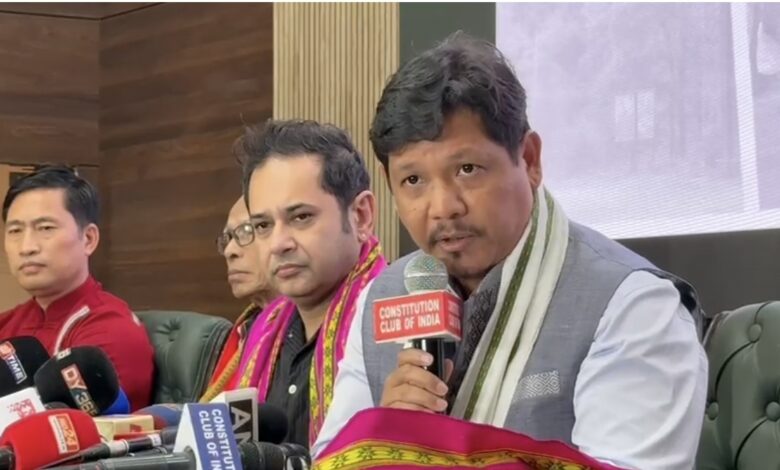Can a unified front truly represent the diverse North East?

 One North East for the betterment of the people of the North East. This was the agenda that brought together Meghalaya Chief Minister Conrad Sangma, Tipra Motha Party founder Pradyut Bikram Manikya Deb Barma, former BJP MLA from Nagaland Mmhonlum Kikon and young political leader from Dima Hasao Daniel Langthasa on the same platform in New Delhi recently.
One North East for the betterment of the people of the North East. This was the agenda that brought together Meghalaya Chief Minister Conrad Sangma, Tipra Motha Party founder Pradyut Bikram Manikya Deb Barma, former BJP MLA from Nagaland Mmhonlum Kikon and young political leader from Dima Hasao Daniel Langthasa on the same platform in New Delhi recently.
The gathering, billed as an attempt to forge a unified regional front, aimed to highlight the issues confronting the eight northeastern states. A committee has been formed in this regard that will prepare a thorough report on the future course of action of the political entity that will be formed.
Though the unified platform will be political in nature, it was made amply clear that the entity would not fight any other party but instead amplify the collective voice of the region. Conrad was quick to stress that the new platform would work with, not against, the central government.
Yet, beneath the rhetoric of unity, several questions emerge.
Missing voices in the room
The absence of representatives from Arunachal Pradesh, Manipur and Mizoram at the announcement raised the first red flag. Why were only the Meghalaya CM, the titular Maharaja from Tripura, a young leader from Assam and a former BJP leader who resigned from the party earlier this year the prominent faces?
Conrad, of course, told journalists that they will approach other northeastern leaders and parties so that the platform can be expanded. But why wasn’t the consultation done before making the decision public?
The missing presence of Assam Chief Minister Himanta Biswa Sarma — arguably the most influential political figure in the Northeast — also fuelled speculation. Is this platform an alternative to NEDA, or a subtle rebuke of Himanta’s dominance?
The paradox of representation
Pradyot Deb Barma’s inclusion is both significant and problematic. The royal scion of Tripura has championed tribal rights in recent years through the Tipra Motha Party, but history weighs heavily on his claim to that cause. The erstwhile monarchy’s role in the dispossession of Tripura’s indigenous people continues to be a sore point. Can the Maharaja-turned-politician truly represent the subaltern voices his ancestors once overshadowed?
A shadow of NEDA
Observers have drawn parallels between this initiative and the North East Democratic Alliance (NEDA), launched in 2016 under Himanta Biswa Sarma to consolidate BJP influence across the region. NEDA, though partisan, successfully brought together most northeastern states under one political umbrella. If Conrad and his colleagues genuinely seek a pan-regional platform for people’s welfare rather than electoral gains, why not repurpose or reform NEDA’s structure for inclusive advocacy?
There is also the North East MPs’ Forum, already meant to articulate the region’s collective voice in Parliament. How the new entity will differ from or cooperate with existing bodies remains unclear.
Politics beneath the unity pitch
With Meghalaya, Tripura and Nagaland heading to polls in 2028, questions about political timing are inevitable. Conrad insists that the individuality of parties like the NPP and Tipra Motha will remain intact. But if each continues to contest elections independently, what real role will this unified platform play during campaigns? Shared ideals often crumble under electoral compulsions, and a coalition without clarity could become a contradiction in itself.
The danger of oversimplified unity
Perhaps the deeper concern lies in the idea itself — the notion of “One North East.” The region’s strength lies in its diversity: over 200 tribes, countless languages, and distinct socio-political realities. Treating the Northeast as a homogenous entity risks flattening these identities.
The problems facing the Northeast are not interchangeable. Can this proposed front speak with one voice on issues as varied as hydropower-induced displacement in Arunachal Pradesh, Inner Line Permit demands in Meghalaya, or refugee crises in Mizoram? True unity must recognise difference, not erase it.
The vision of a common northeastern platform carries promise — but only if it grows from genuine consultation, inclusivity, and respect for each state’s unique context. If this new entity aspires to be the voice of the Northeast, it must first listen to the many voices within it.




